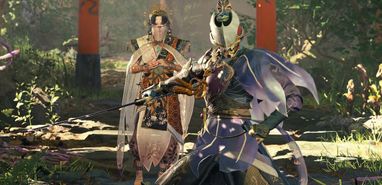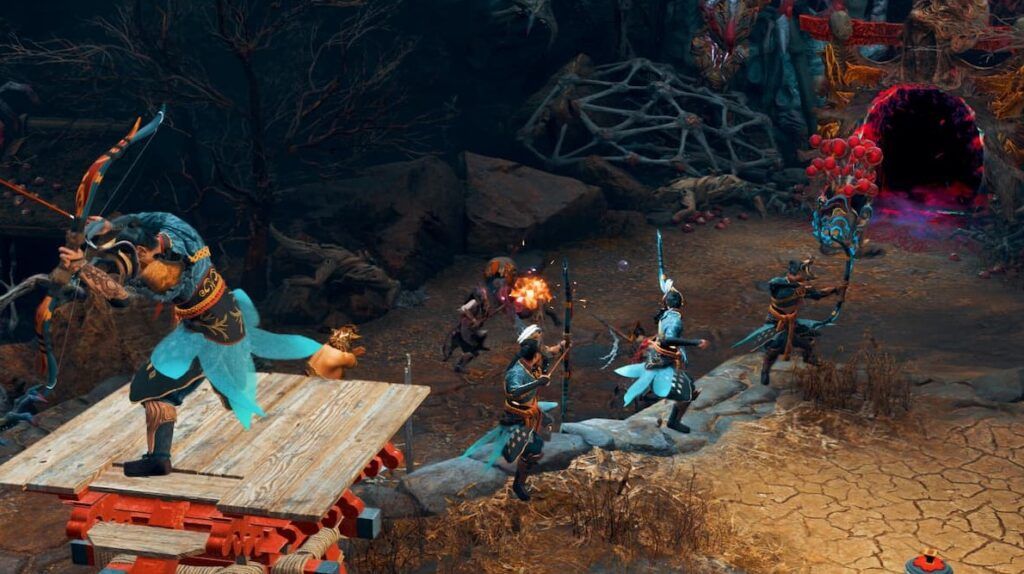
Kunitsu-Gami: Way of the Goddess Review – The Night is Brimming with Dread
With rising development costs and widespread economic challenges affecting the video game industry, major publishers and developers are not as willing to experiment with new IPs as they were a decade or two ago. Supported by the massive success of recent entries in cornerstone franchises like Resident Evil, Monster Hunter, and Street Fighter, CAPCOM seems to be one of the few major publishers still willing to take risks. Following the release of the relatively solid yet short-lived Exoprimal last year, the Japanese publisher is launching another experimental title, Kunitsu-Gami: Way of the Goddess, a blend of tower defense and action games that provides an engaging experience despite some shortcomings.
An Enchanting Yet Sparse Storyline

Set in a beautifully rendered traditional Japanese environment, Kunitsu-Gami: Way of the Goddess sadly lacks a compelling narrative. The insatiable greed of humanity at some point in this world’s history awakened the Seethe, underlings of the corrupted Mountain Goddess. These creatures swept the land, stealing the masks of the villages’ ancestral deities, spreading corruption in their wake, and taking possession of the shrine at the summit of Mt. Kafuku. The only ones who can banish the Seethe and restore order are the Maiden Yoshiro and her protector Soh. They must travel down the mountain to reclaim the stolen masks and perform the Ceremony of Purification, which will open the path to the temple at the summit and grant them the chance to banish the Seethe for good.
Unfortunately, this is all there is to the Kunitsu-Gami: Way of the Goddess story. The Maiden Yoshiro and her protector Soh are silent characters and undergo no development in their journey. The rescued villagers are mostly generic NPCs with limited lines of dialogue during gameplay, only roughly defined by a text description hidden in an in-game menu. To be fair, however, Yoshiro and Soh are immediately recognizable thanks to their visual design and especially their animations, making the numerous cutscenes quite pleasing to watch. Those who expected a deep, compelling narrative to make this journey more meaningful would do well to temper their expectations.
Engaging Gameplay Mechanics

Thankfully, Kunitsu-Gami: Way of the Goddess delivers much better when it comes to gameplay, thanks to its unique blend of genres. During the game’s 20-hour or so campaign, players control Yoshiro’s protector, Soh, who has to create a path called Spirit Path that the Maiden can traverse to reach the main, tainted Torii Gate of each stage to purify it. Reaching this gate, however, is no easy feat. For starters, Soh and Yoshiro start each regular stage with no help, forcing the protector to explore to free villagers from their bonds and purify the defilement that has gripped the location. By doing so, Soh can not only enlist the help of the freed villagers but also obtain powerful Crystals used to assign different roles to them and carve the Spirit Path.
These roles are extremely varied and range from the balanced Woodcutter role to more specialized ones, such as the Ascetic, who can slow down the Seethe for a few seconds; the defensive Sumo Wrestler, who is essentially a tank that can aggro enemies; the Spearman, an offense-focused role with high attack power; the Thief, who can discover treasure around the map; and the Shaman, a supportive role that can heal other villagers in combat. Villagers act independently from the player and will attack Seethe and activate their unique abilities depending on their action range, which can be expanded by spending another currency, Musubi. Additional abilities for all roles can also be learned via upgrades.
The action component of Kunitsu-Gami: Way of the Goddess is represented by Soh themselves. While villagers behave according to their assigned role, the protector is controlled directly by the player. More capable than any of the villagers, Soh can get rid of Seethe with ease thanks to a few handy combos, greater mobility, and some defensive options, like guarding and dodging. The action mechanics are rather straightforward and easy to understand, making it easy to get into the game, even for newcomers to all genres represented in the game.
Gameplay Evolution and Strategy

Topping these mechanics is the gameplay flow of Kunitsu-Gami: Way of the Goddess, which is dictated in a clever way by the passage of time. During the morning, players can explore freely and move around their villagers to prepare for the coming night when the Seethe appears, a feature that seems inspired by Kentaro Miura’s Berserk. The passage of time must also be considered to complete a stage, as Yoshiro takes time to traverse the Spirit Path, and leaving her out in the open at the start of the night could make defending her more difficult. If the Maiden dies, it is game over.
I have to admit that, for the first few hours, Kunitsu-Gami: Way of the Goddess felt like a relatively solid game that seemed afraid to go all-in on both its action and tower defense components. While the game, right from the start, features a decent amount of different enemies against which some roles are more effective than others and introduces varied scenarios, such as stages with multiple possible Spirit Paths, no action component, various contraptions that the carpenter must repair, multiple moving Torii Gates from which the Seethe spawn, and intense boss battles that play unlike the regular stages, forcing players to quickly switch from offense to defense as required by the situation, the experience felt too straightforward due to the limited number of available roles and, most of all, Soh’s limited combat capabilities.
After defeating the Batsu boss around five hours in, however, the experience opens up greatly. At this point, not only will you have plenty of different roles to assign to your villagers, but you will also unlock upgrades for Soh, allowing you to spend Musubi to unlock additional abilities such as extra sword guard slots for special abilities and talisman slots that grant passive skills to customize Soh with, a second fighting style based on draw attacks, Perfect Guard, Ukemi for quick recovery after getting knocked down, additional attacks, Archery Skills, and even some command abilities to smooth out villagers’ management, such as the ability to make them assemble at Soh’s current location.
This is accompanied by a map design that becomes even better than before, as maps start featuring more contraptions, paths placed on different levels, secrets, and so on that really bring out the best of the game’s mechanics, requiring more adjustments on the fly that make the player feel like the general of a very small army that has to adapt to the shifting conditions of the battlefield. The game really comes together at this point, making the first few hours feel more like an extended tutorial. The difficulty level, however, stays a bit too low in my opinion, even in the latter parts of the game, as a simple strategy such as placing villagers close to the Torii Gates is usually more than enough to clear even the most difficult, multi-part long stages, which ends up damaging the experience a bit. Thankfully, the various side objectives available for all stages provide an incentive to vary up the strategy a bit to fulfill them for rewards.
Base Rebuilding and Visuals

Exploring defiled locations and fighting Seethe isn’t the only thing you will do in Kunitsu-Gami: Way of the Goddess, as the game features simple base rebuilding mechanics. After releasing a village from defilement, it will be possible to assign villagers to rebuild it. These mechanics are straightforward, as rebuilding only occasionally requires resources that can be picked up in the village itself, but they provide nice rewards, including Musubi for upgrades and a selection of collectibles that provide additional information on the game’s world. They also provide some welcome respite from all the action, thanks to the soothing piano tracks that play while roaming about purified villages.
Powered by the same RE Engine that has been powering almost every CAPCOM game since the release of Resident Evil VII: Biohazard, Kunitsu-Gami: Way of the Goddess looks gorgeous. Despite the zoomed-back gameplay camera, all characters and locations look incredibly detailed. Characters, in particular, are made even better by the dance-like animations that give them a rather peculiar feel. The highly detailed character models also shine during the cutscenes that play occasionally during Yoshiro and Soh’s journey.
Performance and Technical Aspects

Being an RE Engine-powered game, Kunitsu-Gami: Way of the Goddess runs quite well on PC. The port is undoubtedly well done, featuring the full suite of features expected nowadays, such as NVIDIA DLSS, including Frame Generation and AMD FSR 3 support, ray tracing support, and a good selection of graphics options to tweak. There are also previews of how the different settings impact visual quality and a VRAM usage indicator. With every setting maxed out, the game ran at an average of 77 FPS, 1% 55 FPS at 4K resolution, DLSS Quality setting, no Frame Generation, and max ray tracing during a benchmark session held in the Moegi Ridge stage on the test machine (i7-13700F CPU, RTX 4080 GPU, 32 GB RAM). With Frame Generation enabled and ray tracing turned off, the game ran at a much higher framerate, averaging 154 FPS, 1% Low 74, with little added input delay thanks to NVIDIA Reflex.
Future Prospects and Conclusion

With the majority of major publishers concentrating on their well-established franchises, Kunitsu-Gami: Path of the Goddess stands out as a refreshing change. Despite its slow beginning, moderate difficulty, and minimal storytelling, this hybrid of action and tower defense provides an engaging experience that appeals to a broad range of players, including those who don’t usually play this genre. There is hope that this game will evolve into a series, with future installments addressing the current shortcomings and further enhancing the unique elements that make Kunitsu-Gami: Path of the Goddess so intriguing.








By Andrej Kovacevic
Updated on 18th July 2024